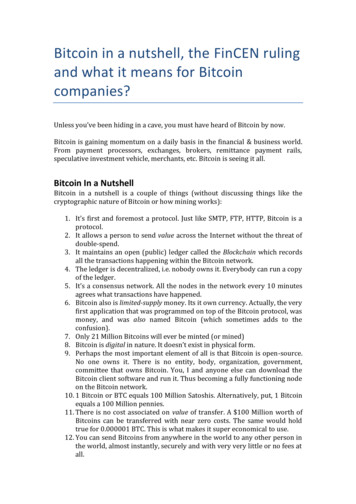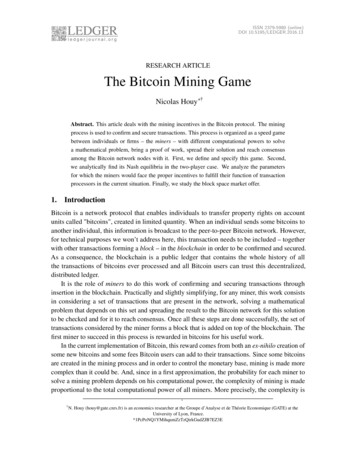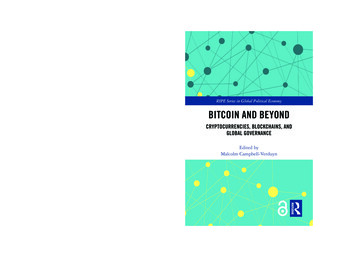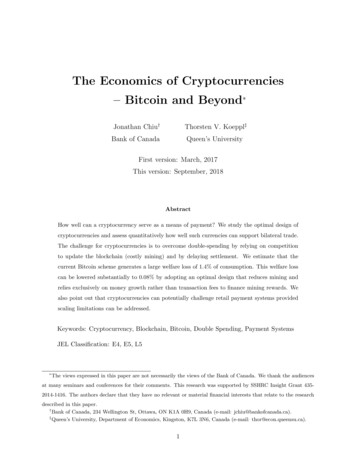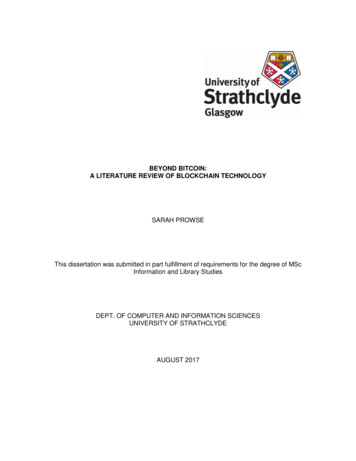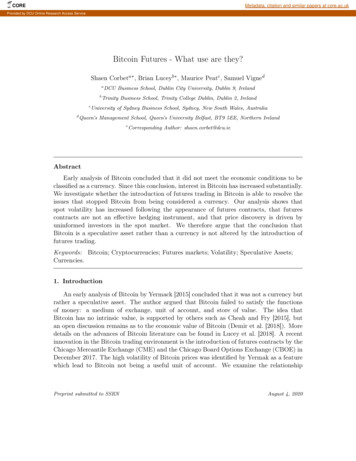
Transcription
COREMetadata, citation and similar papers at core.ac.ukProvided by DCU Online Research Access ServiceBitcoin Futures - What use are they?Shaen Corbeta , Brian Luceyb , Maurice Peatc , Samuel VignedabcdDCU Business School, Dublin City University, Dublin 9, IrelandTrinity Business School, Trinity College Dublin, Dublin 2, IrelandUniversity of Sydney Business School, Sydney, New South Wales, AustraliaQueen’s Management School, Queen’s University Belfast, BT9 5EE, Northern Ireland Corresponding Author: shaen.corbet@dcu.ieAbstractEarly analysis of Bitcoin concluded that it did not meet the economic conditions to beclassified as a currency. Since this conclusion, interest in Bitcoin has increased substantially.We investigate whether the introduction of futures trading in Bitcoin is able to resolve theissues that stopped Bitcoin from being considered a currency. Our analysis shows thatspot volatility has increased following the appearance of futures contracts, that futurescontracts are not an effective hedging instrument, and that price discovery is driven byuninformed investors in the spot market. We therefore argue that the conclusion thatBitcoin is a speculative asset rather than a currency is not altered by the introduction offutures trading.Keywords: Bitcoin; Cryptocurrencies; Futures markets; Volatility; Speculative Assets;Currencies.1. IntroductionAn early analysis of Bitcoin by Yermack [2015] concluded that it was not a currency butrather a speculative asset. The author argued that Bitcoin failed to satisfy the functionsof money: a medium of exchange, unit of account, and store of value. The idea thatBitcoin has no intrinsic value, is supported by others such as Cheah and Fry [2015], butan open discussion remains as to the economic value of Bitcoin (Demir et al. [2018]). Moredetails on the advances of Bitcoin literature can be found in Lucey et al. [2018]. A recentinnovation in the Bitcoin trading environment is the introduction of futures contracts by theChicago Mercantile Exchange (CME) and the Chicago Board Options Exchange (CBOE) inDecember 2017. The high volatility of Bitcoin prices was identified by Yermak as a featurewhich lead to Bitcoin not being a useful unit of account. We examine the relationshipPreprint submitted to SSRNAugust 4, 2020
between futures and spot prices, finding that by contrast to the norm, cash leads thefutures. This we surmise is related to the very high volatility of bitcoin.In December 2017 trading in futures contracts on Bitcoins commenced on the ChicagoMercantile Exchange and the Chicago Board Options Exchange. On the 1st of December,both exchanges announced a Bitcoin futures contract. The CBOE contract commencedtrading on the 10th of December, with each contract being for one Bitcoin. Three aspectsof the introduction of futures on the spot market will be explored. Firstly, the impact offutures trading on spot volatility is examined. Secondly, the hedging effectiveness of futurescontracts is evaluated. Finally, the flow of information between spot and futures marketsis documented.2. DataBoth the CME and the CBOE future contracts are cash settled in US Dollars. Table 1displays stylised facts of these two contracts using data sampled at a one-minute frequencyfrom CBOE futures contract sourced from Thomson Reuters Tick History, and Bitcoinprice data from Thomson Reuters Eikon. We explore the impact of the introduction of riskmanagement tools on the pricing and risk characteristics of the spot Bitcoin market. Fromthe one-minute transaction prices we calculate the log return for each period, presented inFigure 1.Insert Table 1 and Figure 1 about hereThe characteristics of Bitcoin data covering the period from the 26st of September 2017to the 22nd of February 2018 can be found in Table 2. Statistics for the full period and forsub-samples before and after the introduction of futures trading are also presented.Insert Table 2 about hereThere has been a clear change in the distributional characteristics of Bitcoin returnssince the introduction of futures. The mean changed in sign and the standard deviationdoubled; this change in volatility is evident in the time series plot of returns.3. AnalysisThe impact of the introduction of futures trading on volatility in the underlying spotmarket has been investigated for stocks, foreign exchange, interest rates and commodities.The empirical evidence is mixed. Gulen and Mayhew [2000] found a noticeable increasein volatility in the U.S. and Japan, but a negligible effect or decreases in volatility for the2
remaining 23 markets. A recent study of the introduction of futures on European real estateindices by Lee et al. [2014] found that the volatility of the indices fell after the introductionof the futures contracts.We apply tests from the process control literature. These are fully described in Rosset al. [2011] and Ross et al. [2015] to which the interested reader is kindly directed. The Rstatistical package cpm from Ross et al. [2015] is used for all estimation.Two nonparametric statistics are computed, the Mood statistic for changes in volatility(scale) and a Lepage-(type) statistic which tests for changes in location and scale, the resultsof which are presented in Figure 2.Insert Figure 2 about hereBoth the Mood and Lepage statistics indicate a significant change in the distribution,driven by the increase in volatility. The date of the change is the 29th of November 2017,two days before the official announcement of the commencement dates for futures trading.As returns for financial assets have often been found to be non independent and identicallydistributed, the analysis was run on both the raw returns and residuals from a ARMA(1,1)GARCH (1,1). A significant change in the distribution, associated with the increase in seriesvolatility was detected on the 29th of November 2017 in each case.We then measure the extent of risk reduction that can be obtained by forming hedgeportfolios. It is possible that an appropriately constructed hedge portfolio can be used tomanage the volatility of Bitcoin prices. Hedging literature such as Figlewski [1984], Kronerand Sultan [1993], Park and Switzer [1995], Choudhry [2003], concludes that hedge ratiosselected by OLS generally work best when evaluated in sample: we therefore analyse naïveand OLS based hedging strategies. The effectiveness of the hedge can be measured bythe percentage reduction volatility that results from holding the hedge portfolio. We alsocompute hedge effectiveness using semi-variance, which measures the variability of returnsbelow the mean, addressing a shortcoming of the variance and providing a more intuitivemeasure of risk for hedging focused on downside risk.Two hedging approaches are evaluated. The first is the naïve hedge which is a portfoliowith one short futures position for every Bitcoin position, while the second approach isthe Ordinary Least Squares (OLS) hedge. A simple OLS regression of the form rspot α βf uture is run. The estimated β is used as the hedge ratio. This approach to hedging isimplemented using a rolling regression framework. Here, β is estimated each day then usedto compute the hedge portfolio return for the next day. The return series for the hedge isthe concatenation of each days hedge portfolio return. Table 3 contains the results of theevaluation of hedge effectiveness.Insert Table 3 about here3
The first and most striking result is that hedging increases risk, as indicated by thenegative sign of the effectiveness and risk reduction results. While the rolling OLS hedge ismore effective than the naïve hedge, as it would be expected, it also increases the pricingrisk inherent in physically holding Bitcoin. Using semi-variance in the computation of hedgeeffectiveness shows an improvement in effectiveness compared to the use of the variance.However, both the hedging strategies are shown to be increasing risk under all evaluationmethods.It is generally accepted that futures contracts lead their respective underlying assets inprice discovery: see Bohl et al. [2011], Rosenberg and Traub [2009], Cabrera et al. [2009],and Hauptfleisch et al. [2016]. These results highlight the importance of market structureand instrument type. The findings of these studies indicate that the centralisation andrelative transparency of futures markets contribute to their large role in price discovery. Itis also likely that low transaction costs, inbuilt leverage, ease of shorting, and the abilityto avoid holding the underlying physical asset make futures contracts an attractive alternative for traders in a wide range of assets. Bohl et al. [2011] argue that the emergenceof futures markets generally coincides with the rise of instructional trading. The trades ofsophisticated institutional investors contributes to price discovery being focused in futuresmarkets.There are two standard measures of price discovery commonly employed in the literature: the Hasbrouck [1995] Information Share (IS) and the Gonzalo and Granger [1995]Component Share (CS) measure. Hasbrouck [1995] demonstrates that the contribution of aprice series to price discovery (the ‘information share’) can be measured by the proportionof the variance in the common efficient price innovations that is explained by innovations inthat price series. Gonzalo and Granger [1995] decompose a cointegrated price series into apermanent component and a temporary component using error correction coefficients. Thepermanent component is interpreted as the common efficient price, the temporary component reflects deviations from the efficient price caused by trading fractions. We estimate ISand CS, as developed by Hauptfleisch et al. [2016] using the error correction parameters andvariance-covariance of the error terms from the Vector Error Correction Model (VECM): p1,t α1 (p1,t 1 p2,t 1 ) 200Xγi p1,t i i 1 p2,t α2 (p1,t 1 p2,t 1 ) 200Xϕk p1,t k 200Xδj p2,t j ε1,t(1)φm p2,t m ε2,t(2)j 1200Xm 1k 1where pi,t is the change in the log price (pi,t ) of the asset traded in market i attime t. The next stage is to obtain the component shares from the normalised orthogonalcoefficients to the vector of error correction, or:4
CS1 γ1 α1α2; CS2 γ2 α2 α1α1 α2(3)Given the covariance matrix of the reduced form VECM error terms1 where: σ10m110M 1m12 m22ρσ2 σ2 (1 ρ2 ) 2(4)we calculate the IS using:IS1 (γ1 m11 γ2 m12 )2(γ1 m11 γ2 m12 )2 (γ2 m22 )2(5)IS2 (γ2 m22 )2(γ1 m11 γ2 m12 )2 (γ2 m22 )2(6)Recent studies show that IS and CS are sensitive to the relative level of noise in eachmarket, they measure a combination of leadership in impounding new information and therelative level of noise in the price series from each market. The measures tend to overstatethe price discovery contribution of the less noisy market. An appropriate combination of ISand CS cancels out dependence on noise (Yan and Zivot [2010] and Putnin, š [2013]). Thecombined measure is known as the Information Leadership Share (ILS) which is calculatedas:ILS1 IS1 CS2IS2 CS1IS1 CS2IS2 CS1 IS2 CS1IS1 CS2and ILS2 IS2 CS1IS1 CS2IS1 CS2IS2 CS1 IS2 CS1IS1 CS2(7)We estimate all three price discovery metrics, noting that they measure different aspectsof price discovery.Insert Table 4 about hereThe results in Table 4 show that the spot market leads in price discovery according toall the metrics computed. This result is contrary to what has been found in a range of otherasset classes, where futures markets lead. Looking at the Information Leadership Share,97% of the information affecting Bitcoin prices is reflected in the spot market, while theremaining 3% is reflected in the futures market. The concentration of price discovery inthe spot market may be a function of the novelty of the new futures contracts that have1 Ω σ12ρσ1 σ2ρσ1 σ2σ22 and its Cholesky factorisation, Ω M M 0 .5
been trading for 3 months. It may also be the case that the type of investor attracted toBitcoin because of its anonymity may not be inclined to begin trading on a registered andregulated futures market, in which personal details have to be recorded before trading ispermitted; these investors would, however, in general be classified as uninformed. Because ofvarious restrictions on Bitcoin there is an absence of a large cohort of institutional investorswho have positions in physical Bitcoin. The results presented support the argument putforward by Bohl et al. [2011] that the dominance of unsophisticated individual investors inthe futures market impedes its contribution to price discovery.4. ConclusionsA currency has three economic attributes: it is a medium of exchange, a store of value,and a unit of account. Yermack [2015] asserted that Bitcoin was not a currency as itperforms poorly as a unit of account and as a store of value. The high volatility of Bitcoinprices and the range of prices quoted on various Bitcoin exchanges were seen to damageBitcoin’s usefulness as a unit of account. If the introduction of Bitcoin futures and theability to trade these would have resulted in a reduction in the variance of Bitcoin prices,or facilitated hedging strategies that could have mitigated pricing risk in the spot market,it is possible that the Bitcoin could have acted as a unit of account, moving it closerto being a currency. The analysis conducted shows that volatility increased around theannouncement of trading in Bitcoin futures. In the period covered by this study hedgeportfolios constructed with futures cannot mitigate the risk inherent in the underlying spotmarket; both hedging strategies considered resulted in an increase in volatility. The pricediscovery analysis indicated that price discovery is focused on the spot market, which isin keeping with the argument that the traders in the futures market are uninformed noisetraders. Together these results support the conclusion of Yermack [2015] that Bitcoin shouldbe seen as a speculative asset rather than a currency.6
BibliographyBohl, M. T., C. A. Salm, and M. Schuppli (2011). Price discovery and investor structurein stock index futures. Journal of Futures Markets 31 (3), 282–306.Cabrera, J., T. Wang, and J. Yang (2009). Do futures lead price discovery in electronicforeign exchange markets? Journal of Futures Markets 29 (2), 137–156.Cheah, E.-T. and J. Fry (2015). Speculative bubbles in bitcoin markets? an empiricalinvestigation into the fundamental value of bitcoin. Economics Letters 130, 32–36.Choudhry, T. (2003). Short-run deviations and optimal hedge ratio: evidence from stockfutures. Journal of Multinational Financial Management 13 (2), 171–192.Demir, E., G. Gozgor, C. K. M. Lau, and S. A. Vigne (2018, jan). Does economic policyuncertainty predict the Bitcoin returns? An empirical investigation. Finance ResearchLetters (Forthcoming).Figlewski, S. (1984). Hedging performance and basis risk in stock index futures. TheJournal of Finance 39 (3), 657–669.Gonzalo, J. and C. Granger (1995). Estimation of common long-memory components incointegrated systems. Journal of Business & Economic Statistics 13 (1), 27–35.Gulen, H. and S. Mayhew (2000). Stock index futures trading and volatility in internationalequity markets. Journal of Futures Markets: Futures, Options, and Other DerivativeProducts 20 (7), 661–685.Hasbrouck, J. (1995). One security, many markets: Determining the contributions to pricediscovery. The journal of Finance 50 (4), 1175–1199.Hauptfleisch, M., T. J. Putnin, š, and B. Lucey (2016). Who sets the price of gold? londonor new york. Journal of Futures Markets 36 (6), 564–586.Kroner, K. F. and J. Sultan (1993). Time-varying distributions and dynamic hedging withforeign currency futures. Journal of financial and quantitative analysis 28 (4), 535–551.Lee, C. L., S. Stevenson, and M.-L. Lee (2014). Futures trading, spot price volatility andmarket efficiency: evidence from european real estate securities futures. The Journal ofReal Estate Finance and Economics 48 (2), 299–322.Lucey, B. M., S. A. Vigne, L. Ballester, L. Barbopoulos, J. Brzeszczynski, O. Carchano,N. Dimic, V. Fernandez, F. Gogolin, A. González-Urteaga, J. W. Goodell, P. Helbing,R. Ichev, F. Kearney, E. Laing, C. J. Larkin, A. Lindblad, I. Lončarski, K. C. Ly,M. Marinč, R. J. McGee, F. McGroarty, C. Neville, M. O’Hagan-Luff, V. Piljak, A. Sevic,7
X. Sheng, D. Stafylas, A. Urquhart, R. Versteeg, A. N. Vu, S. Wolfe, L. Yarovaya, andA. Zaghini (2018). Future directions in international financial integration research - Acrowdsourced perspective. International Review of Financial Analysis 55, 35–49.Park, T. H. and L. N. Switzer (1995). Bivariate garch estimation of the optimal hedgeratios for stock index futures: a note. Journal of Futures Markets 15 (1), 61–67.Putnin, š, T. J. (2013). What do price discovery metrics really measure? Journal of EmpiricalFinance 23, 68–83.Rosenberg, J. V. and L. G. Traub (2009). Price discovery in the foreign currency futuresand spot market. The Journal of Derivatives 17 (2), 7–25.Ross, G. J. et al. (2015). Parametric and nonparametric sequential change detection in r:The cpm package. Journal of Statistical Software 66 (3), 1–20.Ross, G. J., D. K. Tasoulis, and N. M. Adams (2011). Nonparametric monitoring of datastreams for changes in location and scale. Technometrics 53 (4), 379–389.Yan, B. and E. Zivot (2010). A structural analysis of price discovery measures. Journal ofFinancial Markets 13 (1), 1–19.Yermack, D. (2015). Is bitcoin a real currency? an economic appraisal. In Handbook ofDigital Currency, pp. 31–43. Elsevier.8
Figure 1: Price and returns time series over the full sample period9
Figure 2: Change Point Detection10Note: The above figure presents the Raw Returns Mood Statistics (Top Panel) and GARCH(1,1) Residuals Mood Statistic (Bottom Panel) respectively. These twononparametric statistics represent the Mood statistic for change in volatility (scale) and a Lepage type statistic which tests for a change in location and scale. Theimplementation of these statistics for change point detection was executed relying on the cpm package in R and is used to establish the existence and location of a changepoint in the Bitcoin price series. Both the Mood and Lepage statistics indicate there is a significant change in the distribution, driven by the increase in volatility. The dateof the change is the 29th of November 2017, two days before the official announcement of the commencement dates for futures trading.
Table 1: Stylised facts based on Cboe and CME Bitcoin FuturesVariableProduct CodeFirst TradedContract unitMinimum Price FluctuationPosition LimitsPrice LimitsSettlementCBOE FuturesXBT10th of December 20171 Bitcoin10.00 points USD/XBT (equal to 10.00 per contract).A person: (i) may not own or controlmore than 5,000 contracts net long ornet short in all XBT futures contractexpirations combined and (ii) may notown or control more than 1,000 contracts net long or net short in theexpiring XBT futures contract, commencing at the start of trading hours 5business days prior to the Final Settlement Date of the expiring XBT futurescontract.XBT futures contracts are not subjectto price limits.The Final Settlement Value of an expiring XBT futures contract shall bethe official auction price for Bitcoin inU.S. dollars determined at 4:00 p.m.Eastern Time on the Final SettlementDate by the Gemini Exchange Auction.11CME FuturesBTC18th of December 20175 Bitcoins 5.00 per bitcoin 25.00 per contract.1,000 contracts with a position accountability level of 5,000 contracts.7% above and below settlement price, /-13% previous settlement, /-20%for prior settlement.Cash settled by reference to Final Settlement Price.
Table 2: Descriptive Statistics for Bitcoin Prices and ReturnsPanel A - Full SampleMeanStandard ErrorMedianModeStandard DeviationSample Panel B - Pre Futures IntroductionMeanStandard ErrorMedianModeStandard DeviationSample nel C - Post Futures IntroductionMeanStandard ErrorMedianModeStandard DeviationSample ble 3: Hedge EffectivenessNaive HedgeRisk ReductionHedge 9-3.3459-1.20851Rolling OLS HedgeRisk ReductionHedge 27-0.60763-0.3891912
Table 4: Price Discovery ResultsInformation Share (Hasbruck)FuturesBitcoinLower BoundUpper 370.850363Component Share resBitcoinLeadershipInformationLeadershipShare 56360.827931Average0.0300340.96996513
Bitcoin Futures - What use are they? ShaenCorbeta,BrianLuceyb,MauricePeatc,SamuelVigned aDCU Business School, Dublin City University, Dublin 9, Ireland bTrinity Business School, Trinity College Dublin, Dublin 2, Ireland cUniversity of Sydney Business School, Sydney, New South Wales, Australia dQueen’s



